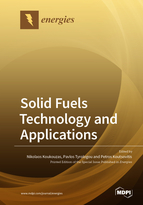Solid Fuels Technology and Applications.
A special issue of Energies (ISSN 1996-1073). This special issue belongs to the section "D: Energy Storage and Application".
Deadline for manuscript submissions: closed (30 June 2020) | Viewed by 23040
Special Issue Editors
Interests: energy storage and policy; hydrogen; carbon capture and stotage; geo-engineering; hydro-pump energy storage; nanomaterials; land reclamation; ultramafic rocks petrology; industrial minerals; critical raw materials
Special Issues, Collections and Topics in MDPI journals
Interests: geological engineering; environmental impact assessment; contaminated land; renewable energy; water resources; climate change; vulnerability; sustainability; fragility; CO2 sequestration
Special Issues, Collections and Topics in MDPI journals
Interests: petrology; mineralogy; geochemestry; CCUS; reneable energy; energy storage system
Special Issues, Collections and Topics in MDPI journals
Special Issue Information
Dear Colleagues,
We are pleased to invite you to contribute your article to an upcoming Special Issue entitled “Solid Fuels Technology and Applications”, which will be published in Energies. This Special Issue is open to researchers and authors that would like to submit their research and review articles that explore the application of solid fuels technologies. The aim of this Issue is to contribute to knowledge of ongoing research on solid fuels technological applications.
Dr. Nikolaos KoukouzasDr. Pavlos Tyrologou
Dr. Petros Koutsovitis
Guest Editors
Manuscript Submission Information
Manuscripts should be submitted online at www.mdpi.com by registering and logging in to this website. Once you are registered, click here to go to the submission form. Manuscripts can be submitted until the deadline. All submissions that pass pre-check are peer-reviewed. Accepted papers will be published continuously in the journal (as soon as accepted) and will be listed together on the special issue website. Research articles, review articles as well as short communications are invited. For planned papers, a title and short abstract (about 100 words) can be sent to the Editorial Office for announcement on this website.
Submitted manuscripts should not have been published previously, nor be under consideration for publication elsewhere (except conference proceedings papers). All manuscripts are thoroughly refereed through a single-blind peer-review process. A guide for authors and other relevant information for submission of manuscripts is available on the Instructions for Authors page. Energies is an international peer-reviewed open access semimonthly journal published by MDPI.
Please visit the Instructions for Authors page before submitting a manuscript. The Article Processing Charge (APC) for publication in this open access journal is 2600 CHF (Swiss Francs). Submitted papers should be well formatted and use good English. Authors may use MDPI's English editing service prior to publication or during author revisions.
Keywords
- solid fuels
- energy technologies
- renewable solutions
- sustainability








